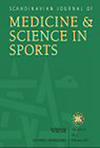12岁耐力运动员及其非耐力训练同龄人最大摄氧量和心血管功能的前瞻性研究
IF 3.5
2区 医学
Q1 SPORT SCIENCES
引用次数: 0
摘要
接受过耐力训练的青少年的最大摄氧量(V̇O2max)通常高于未接受过耐力训练的同龄人。然而,造成这种情况的具体机制以及在这一发育阶段进行训练的影响仍不清楚。本研究旨在比较12岁耐力运动员和未接受耐力训练的青少年在14个月内的最大容积和心血管功能。在14个月期间,对一组青少年越野滑雪运动员(END,n = 42,年龄:12.4 ± 0.5,女孩:n = 27)和一组对照组(CON,n = 26,年龄:12.3 ± 0.3,女孩:n = 15)进行了四次人体测量、V⋅J⋅O2max、血红蛋白质量(Hbmass)、血容量(BV)和左心室形态学评估。在为期 14 个月的随访中,END 比 CON 每周进行更多的训练(7.0 ± 2.3 对 2.5 ± 2.4 小时,p < 0.001),其中只有END 进行了耐力训练。相对于无脂体重(FFM),END 的 V̇O2max 比 CON 高出约 18%(p < 0.001)。END相对于FFM的卒中容积(SV)和左心室舒张末期容积(LV EDV)也比CON高(p < 0.001和0.004),而Hbmass和BV没有发现显著差异。对于 V̇O2max(p = 0.352-0.767)或任何心血管参数(p = 0.131-0.956)的绝对值或相对于 FFM 而言,组别和时间均无明显交互作用。总之,与 CON 组相比,END 组显示出更高的 V̇O2max、左心室 EDV 和 SV,而 BV 和 Hbmass 没有显著差异。尽管在训练量上存在很大差异,但在 14 个月的时间里,两组在这些变量上的进展情况相似。本文章由计算机程序翻译,如有差异,请以英文原文为准。
A Prospective Study on Maximal Oxygen Uptake and Cardiovascular Functions in 12‐Year‐Old Endurance Athletes and Their Non‐Endurance‐Trained Peers
The maximal oxygen uptake (V̇O2max ) is typically higher in endurance‐trained adolescents than in non‐endurance‐trained peers. However, the specific mechanisms contributing to this remain unclear, as well as the impact of training during this developmental stage. This study aims to compare V̇O2max and cardiovascular functions between 12‐year‐old endurance athletes and non‐endurance‐trained over a 14‐month period. Anthropometrics, V̇O2max , hemoglobin mass (Hbmass ), blood volume (BV), and left‐ventricular morphology were assessed four times over the 14 months in a group of young cross‐country skiers (END, n = 42, age: 12.4 ± 0.5, girls: n = 27) and a group of controls (CON, n = 26, age: 12.3 ± 0.3, girls: n = 15). Throughout the 14‐month follow‐up, END did more weekly training than CON (7.0 ± 2.3 vs. 2.5 ± 2.4 h, p < 0.001), with only END conducting endurance training. END had ~18% higher V̇O2max relative to fat‐free mass (FFM) than CON (p < 0.001). Stroke volume (SV) and left ventricular end‐diastolic volume (LV EDV) relative to FFM were also higher for END than CON (p < 0.001 and 0.004), while no significant differences were found for Hbmass and BV. No significant interaction was seen for group and time for V̇O2max (p = 0.352–0.767) or any cardiovascular parameters (p = 0.131–0.956) in absolute measures or relative to FFM. In conclusion, the END group exhibited higher V̇O2max , LV EDV, and SV compared to the CON group, with no significant difference in BV and Hbmass . Despite substantial differences in training volume, the progression of these variables over the 14‐month period was similar in both groups.
求助全文
通过发布文献求助,成功后即可免费获取论文全文。
去求助
来源期刊
CiteScore
7.90
自引率
4.90%
发文量
162
审稿时长
3 months
期刊介绍:
The Scandinavian Journal of Medicine & Science in Sports is a multidisciplinary journal published 12 times per year under the auspices of the Scandinavian Foundation of Medicine and Science in Sports.
It aims to publish high quality and impactful articles in the fields of orthopaedics, rehabilitation and sports medicine, exercise physiology and biochemistry, biomechanics and motor control, health and disease relating to sport, exercise and physical activity, as well as on the social and behavioural aspects of sport and exercise.

 求助内容:
求助内容: 应助结果提醒方式:
应助结果提醒方式:


